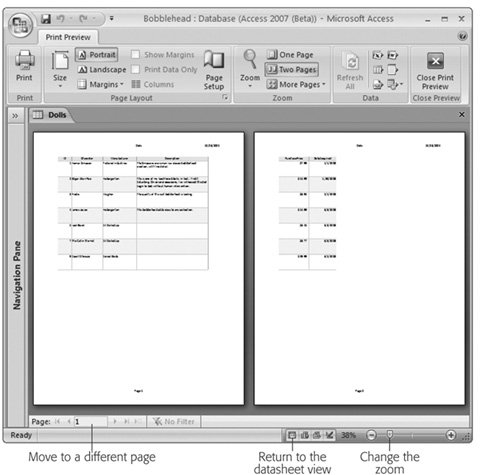Section 3.4. Printing the Datasheet
3.4. Printing the Datasheet If you want to study your data at the dinner table (and aren't concerned about potential conflicts with non-Access-lovers), nothing beats a hard copy of your data. You can dash off a quick printout by choosing File The key problem's that Access isn't bothered about tables that are too wide to fit on a printed page. It deals with them by splitting the printout into separate pages. If you have a large table and you print it out using the standard Access settings, you could easily end up with a printout that's four pages wide and three pages long. Assembling this jigsaw is not for the faint of heart. To get a better printout, it's absolutely crucial that you preview your table before you print it, as described in the next section. 3.4.1. Print Preview The print preview feature in Access gives you the chance to tweak your margins, paper orientation, and so on, before you send your table to the printer. This way, you can make sure the final printout's genuinely usable. To preview a table, open it (or select it in the navigation pane), and then choose Office button The print preview shows a picture of what your data will look like once it's committed to paper. Unlike the datasheet view, the print preview paginates your data (Figure 3-20). You see exactly what fits on each page and how many pages your printout requires (and what content shows up on each page).
If you decide you're happy with what you see, then you can fire off your printout by choosing Print Preview When you're finished looking at the print preview window, choose Print Preview 3.4.1.1. Moving around the print previewYou can't change anything in the print preview window. However, you can browse through the pages of your virtual printout and see if it meets your approval. Here's how you can get around in the preview window:
3.4.1.2. Changing the page layout Access provides a small set of page layout options that you can tweak using the ribbon's Print Preview
3.4.2. Fine-Tuning a PrintoutBased on the limited page layout options, you might assume that there's not much you can do customize a printout. However, you actually have more control than you realize. Many of the formatting options that you've learned about in this chapter also have an effect on your printout. By applying the right formatting, you can create a better printout. Here are some pro printing tips that explain how different formatting choices influence your printouts:
The only challenge you face when using these settings is the fact that you can't set them from the print preview window. Instead, you have to set them in the datasheet, jump to the print preview window to see the result, jump back to the datasheet to change them a little bit more, jump back to the print preview window, and so on. This process can quickly get tiring. Tip: Don't spend too much time tweaking the formatting options to create the perfect printout. If you have a large table that just can't fit gracefully into a page, you probably want to use reports , which are described in Part Three. They provide much more formatting muscle, including the ability to split fields over several lines, separate records with borders, and allow large values to take up more space by gently bumping other information out of the way. |
- Article 406: Receptacles, Cord Connectors, and Attachment Plugs (Caps)
- Article 411: Lighting Systems Operating at 30 Volts or Less
- Article 426: Fixed Outdoor Electric De-Icing and Snow-Melting Equipment
- Notes for Tables 11(A) and 11(B)
- Example No. D2(c) Optional Calculation for One-Family Dwelling with Heat Pump(Single-Phase, 240/120-Volt Service) (See 220.82)
 Print from the menu while your datasheets visible. However, the results you get will probably disappoint you, particularly if you have a large table.
Print from the menu while your datasheets visible. However, the results you get will probably disappoint you, particularly if you have a large table. 